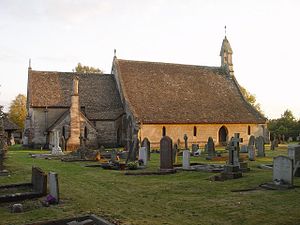- St Saviour's Church, Tetbury
-
St Saviour's Church, Tetbury 
St Saviour's Church, Tetbury, from the northLocation in Gloucestershire Coordinates: 51°38′17″N 2°09′49″W / 51.6380°N 2.1635°W OS grid reference ST 887 932 Location Tetbury, Gloucestershire Country England Denomination Anglican Website Churches Conservation Trust History Consecrated 1848 Architecture Functional status Redundant Heritage designation Grade II* Designated 21 March 1985 Architect(s) Samuel Daukes
A. W. N. Pugin
John HardmanArchitectural type Church Style Gothic Revival Completed 1848 Specifications Materials Stone,
Cotswold stone roofsSt Saviour's Church, Tetbury, is a redundant 19th-century Anglican church in the town of Tetbury, Gloucestershire, England (grid reference ST887932). Designed by the local architect Samuel Daukes, assisted by A. W. N. Pugin and John Hardman,[1] St Saviour's been designated by English Heritage as a Grade II* listed building,[2] and is under the care of the Churches Conservation Trust.[1]
Contents
History
The church was built in 1848 as a chapel of ease in the parish of St Mary the Virgin's Church, Tetbury.[3] At that time the richer people paid a fee for the use of a pew in St Mary's (a pew rent). St Saviour's was built for the poorer people who could not afford this charge,[1][4] and it came to be described as "a little church for the poor".[5] The church was designed by the local architect Samuel Daukes, who was assisted by A. W. N. Pugin and John Hardman.[1] The church was declared redundant in 1974.[3]
Architecture
Exterior
St Saviour's is a Gothic Revival church in the Decorated Gothic style, built in local stone with Cotswold stone roofs.[1] The plan has a nave with side aisles and a chancel from which projects a north vestry. The main entrance is through a south porch into the nave. The church has steeply gabled ends, which project beyond the roofline, terminating in small crosses and, at the western end, a bellcote. There is no clerestory, the roof of the nave extending into catslides of a less steep pitch over the aisles. The corners of the building have splayed stepped buttresses, with two more buttresses occurring on the west front, at the ends of the aisles.[2]
The main windows of the church have tracery in the Flowing Decorated Gothic style of the early 1300s, that at the east of the chancel being the largest with three lights. There are two light windows in the south wall of the chancel, the ends of the aisles and a larger two light window into the nave. High in the nave gables are two small rose windows. The sides of the aisles are lit by small lancets.[2]
Interior
Inside the church the nave is separated from the aisles by arcades of four bays supported on alternate round and octagonal piers. All the fittings date from the time of the building of the church. These include the pews with poppyhead ends, the stone font, the stone pulpit, and the wooden chancel screen.[2] The original gas fittings are still in the church, although they are no longer functioning. These include the pipes, the wall brackets, and on the top of the chancel screen, a burner bar consisting of a row of gas jets.[4][5] The organ formerly in the church has been removed.[6]
External features
The lychgate is designated as a Grade II listed building. It is thought to be contemporary with the church, and is built in stone with a Cotswold slate roof.[7]
See also
- List of churches preserved by the Churches Conservation Trust in the English Midlands
References
- ^ a b c d e St Saviour's Church, Tetbury, Gloucestershire, Churches Conservation Trust, http://www.visitchurches.org.uk/Ourchurches/Completelistofchurches/St-Saviours-Church-Tetbury-Gloucestershire/, retrieved 29 March 2011
- ^ a b c d "Church of St Saviour, Tetbury", Heritage Gateway website (Heritage Gateway (English Heritage, Institute of Historic Building Conservation and ALGAO:England)), 2006, http://www.heritagegateway.org.uk/Gateway/Results_Single.aspx?uid=128584&resourceID=5, retrieved 14 November 2010
- ^ a b Herbert, N. M.; Pugh, R. B., eds. (1976), "Bisley and Longtree Hundreds:Tetbury; Church", A History of the County of Gloucester, Victoria County History (University of London & History of Parliament Trust) 11: pp. 277–280, http://www.british-history.ac.uk/report.aspx?compid=19147#s1, retrieved 14 November 2010
- ^ a b Tetbury, St Saviour's Church, Britain Express, http://www.britainexpress.com/attractions.htm?attraction=4215, retrieved 14 November 2010
- ^ a b St Saviour's Church, Tetbury, Chartered Institution of Building Services Engineers, http://www.hevac-heritage.org/items_of_interest/lighting/st_saviour%27s_tetbury/st_saviour%27s_tetbury.htm, retrieved 14 November 2010
- ^ Buildings found, British Institute of Organ Studies, http://www.npor.org.uk/cgi-bin/NPORSearch.cgi?, retrieved 14 November 2010
- ^ "Lychgate at Church of St Saviour, Tetbury", Heritage Gateway website (Heritage Gateway (English Heritage, Institute of Historic Building Conservation and ALGAO:England)), 2006, http://www.heritagegateway.org.uk/Gateway/Results_Single.aspx?uid=128585&resourceID=5, retrieved 14 November 2010
Categories:- Grade II* listed buildings in Gloucestershire
- Grade II* listed churches
- Church of England churches in Gloucestershire
- Gothic Revival architecture in England
- 1848 architecture
- Churches preserved by the Churches Conservation Trust
Wikimedia Foundation. 2010.

